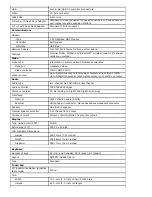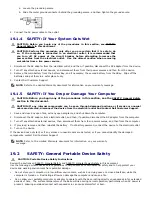
interface controller).
NIC — See network adapter.
notification area — The section of the Windows taskbar that contains icons for providing quick access to programs and
computer functions, such as the clock, volume control, and print status. Also referred to as system tray.
ns — nanosecond — A measure of time that equals one billionth of a second.
NVRAM — nonvolatile random access memory — A type of memory that stores data when the computer is turned off or
loses its external power source. NVRAM is used for maintaining computer configuration information such as date, time,
and other system setup options that you can set.
O
optical drive — A drive that uses optical technology to read or write data from CDs, DVDs, or DVD+RWs. Example of
optical drives include CD drives, DVD drives, CD-RW drives, and CD-RW/DVD combo drives.
P
parallel connector — An I/O port often used to connect a parallel printer to your computer. Also referred to as an LPT
port.
partition — A physical storage area on a hard drive that is assigned to one or more logical storage areas known as logical
drives. Each partition can contain multiple logical drives.
PC Card — A removable I/O card adhering to the PCMCIA standard. Modems and network adapters are common types of
PC Cards.
PCI — Peripheral Component Interconnect — PCI is a local bus that supports 32-and 64-bit data paths, providing a high-
speed data path between the processor and devices such as video, drives, and networks.
PCI Express — A modification to the PCI interface that boosts the data transfer rate between the processor and the
devices attached to it. PCI Express can transfer data at speeds from 250 MB/sec to 4 GB/sec. If the PCI Express chip set
and the device are capable of different speeds, they will operate at the slower speed.
PCMCIA — Personal Computer Memory Card International Association — The organization that establishes standards for
PC Cards.
PIO — Programmed Input/Output — A method of transferring data between two devices through the processor as part of
the data path.
pixel — A single point on a display screen. Pixels are arranged in rows and columns to create an image. A video
resolution, such as 800 x 600, is expressed as the number of pixels across by the number of pixels up and down.
Plug-and-Play — The ability of the computer to automatically configure devices. Plug and Play provides automatic
installation, configuration, and compatibility with existing hardware if the BIOS, operating system, and all devices are Plug
and Play compliant.
POST — Power-On Self-Test — Diagnostics programs, loaded automatically by the BIOS, that perform basic tests on the
major computer components, such as memory, hard drives, and video. If no problems are detected during POST, the
computer continues the startup. processor — A computer chip that interprets and executes program instructions.
Sometimes the processor is referred to as the CPU (central processing unit).
PS/2 — Personal System/2 — A type of connector for attaching a PS/2-compatible keyboard, mouse, or keypad.
PXE — pre-boot execution environment — A WfM (Wired for Management) standard that allows networked computers that
do not have an operating system to be configured and started remotely.
Q
QuadCool – The multi-faceted Thermal Management System that combines enhanced forced convection and conductive
cooling focused on the internal core system components, primary memory, storage and smart battery
elements. QuadCool Technology moves heat away from core system components and elements to the exterior of the
system.
R
RAID — Redundant Array of Independent Disks — A method of providing data redundancy. Some common
implementations of RAID include RAID 0, RAID 1, RAID 5, RAID 10, and RAID 50.
RAM — Random-Access Memory — The primary temporary storage area for program instructions and data. Any
information stored in RAM is lost when you shut down your computer.
readme file — A text file included with a software package or hardware product. Typically, readme files provide installation
information and describe new product enhancements or corrections that have not yet been documented.




































